War Stories 3
Enjoy the stories in this section. Some of them may even have been true!! Have a favorite war story you've been relating over the years? Well sit down
and shoot us a draft of it. Don't worry, we'll do our best to correct grammar, punctuation, and spelling before we publish it. to us and we'll publish them for all to enjoy.

Those Cav MEDEVACS;
They Just Won't Give Up
By PFC Nick Matuszeck
Phouc Vinh - Two wounded infantrymen, were finally pulled from the
jungle near the Song Be Bridge recently, but not before two Medevac
helicopters were shot down in the effort to get them out. Before being
rescued, one wounded man, dropped by one of the birds before it crashed,
spent an hour strapped to a semi-rigid litter listening to the enemy moving
around his location.
The incident began when three wounded members of the 25th Infantry
Division's 91-A element were being extracted from the jungle near the Song
Be Bridge in Binh Duong Province. Before they could pull out, the intense
enemy fire brought down the “DUSTOFF” bird supporting the 25th
before they could be pulled out.
While 25th. Infantry Division Cobras circled high above, a Medevac
bird from the 1st. Air Cavalry Division's 15th Medical Battalion answered
the "Mayday" call from the stricken aircraft.

CW2 Joel Morris
Warrant Officer Joel Morris, 'Medevac 26" Commander, rushed to the crash site and,
communicating with ground units, found the crew of the downed bird had been
rescued. However, there were still three critically wounded men on the
ground who needed immediate evacuation. Morris briefed his crew on their
individual responsibilities, then called the ground unit for approach
instructions. As the bird came in low over the high jungle canopy and
prepared to drop the semi-rigid litter by cable, muzzle flashes were spotted
from enemy gun emplacements. The door gunners, SP5 Robert Valencia, and SP4
Daniel Weaver, opened hot and heavy with their machineguns to suppress the
enemy fire. After quickly taking the craft out of range Morris and Warrant
Officer Barry Brown, the Co-Pilot, came in for another approach from a
different route. As the bird hovered over the jungle, SP4 Gregory Shafer,
the Medic, and Crew Chief Jonathan Hodges lowered the hoisting cable and the
litter through the treetops. But the enemy gunners soon zeroed in on the
stationary chopper as the crew exposed itself while struggling to hoist the
first injured man to safety.
Despite their efforts, however, the rescue had to be aborted as
several burst of automatic weapons fire tore into the chopper's
transmission. The patient below, strapped to the litter, was at a height of
about five feet when the chopper crew was forced to cut him loose as they
rapidly lost altitude. Pilot Morris barely got the bird to a small clearing
where he crash-landed the aircraft. After a quickly called appeal over the
radio for help, Morris and his crew abandoned the burning aircraft. Armed
with two M-60 machineguns and their pistols, they prepared for the worst and
set up a defensive perimeter around their burning ship.
Fortunately, a rescue aircraft reached them ahead of the enemy and
they were soon on their way to safety. The commander of the second bird,
Chief Warrant Officer Christopher Wickland, found himself faced with the
same situation as the previous rescue pilot: the flight crew he'd intended
to rescue was already out, but wounded men remained with the ground unit. To
add almost unbearable urgency to the situation, the man who'd been dropped
still hadn't been found. With the gunners pouring out suppressing fire, the
extraction of the first patient went without a hitch as the crew exposed
themselves to possible fire. A quick flight to Phouc Vinh to rush the
wounded man to medical aid was followed by the successful search for the
dropped litter patient.
Even though his chances for survival were thin, the crew of
"MEDEVAC 18" refused to abandon him. Wickland was told by the ground unit
that the first bird had carried the litter approximately 30 meters from the
pickup site before dropping it. Assisted by an LOH, Wickland and his crew
began an intensive search for the downed man and litter. Finally, the LOH
crew spotted the wounded man waving from a nearly concealed spot in the
brush. The Medevac bird dropped down near his location, crewmembers hanging
out the doors onto the skids to spot the man's position. Fortunately, the
bird was able to come low enough to allow Victor and SP4 Joe Kelly, the
Medic, to jump to the ground, gather up the wounded man on the litter, and
load him back into the bird for the life-saving flight to Phouc Vinh.
The patient later told of lying in the brush for an hour, unable to
move and in pain, listening to the enemy moving in the brush around him. In
an impact awards ceremony following the action, Brigadier General Jonathan
R. Burton, Assistant Division Commander of the 1st. Cavalry Division
Commended the courage of the crews of MEDEVAC 18 and 26. Every member of
MEDEVAC 26-Morris, Brown, Valencia, Weaver, Shafer and Hodges received
Distinguished Flying -Crosses. Aircraft Commander Wickland and Pilot Simpson
of MEDEVAC 18 also received Distinguished Flying Crosses, while Kelly,
Sparkman, and Victor each received air medals for Valor.
[ Return To Index
]

Medevac Proves Invaluable Asset
1970 - Phuoc Vinh, RVN
By: Mark "Doc" Holiday
The cry of the hurt goes out and Medevac crews scramble. They care.
Nearly five years ago, the 15th Medical Battalion, of the First Cavalry
Division (Airmobile), became the first such Army unit with organic aviation.
Since then, 15th Med has repeatedly proven its value: invaluable in terms of
human suffering lessened and lives saved. In Vietnam, the rugged terrain has
often made the air ambulance role difficult. The unavailability of a landing
zone, in areas of dense jungle, necessitated the use of a hoist for bringing
wounded men aboard the aircraft. The use of a hoist and jungle penetrator,
or semi-rigid litter, has saved many lives. But the use of these pieces of
vital equipment can be extremely hazardous.
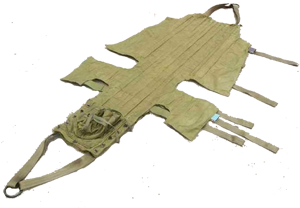 The
Medevac helicopter, hovering above the jungle, is a stationary target for
enemy gunners. In fact, the wounded man himself is an inviting target. A
ground infantry unit is in contact with an enemy force. The Commander
informs the Medevac Pilot that a hoist mission will be necessary, while the
aircraft is still en route to the contact site. Smoke is popped and the
helicopter crew drops a semi-rigid polless litter to the men below. The
helicopter then circles the area as the wounded man is strapped into the
device. When all is ready, on the ground, the helicopter hovers over the
treetops. The ground troops put out an enormous amount of fire, to keep the
enemy's heads down. The door gunner and crew chief opened up with their
M-60s, as ugly green tracers scream past their ship.
The
Medevac helicopter, hovering above the jungle, is a stationary target for
enemy gunners. In fact, the wounded man himself is an inviting target. A
ground infantry unit is in contact with an enemy force. The Commander
informs the Medevac Pilot that a hoist mission will be necessary, while the
aircraft is still en route to the contact site. Smoke is popped and the
helicopter crew drops a semi-rigid polless litter to the men below. The
helicopter then circles the area as the wounded man is strapped into the
device. When all is ready, on the ground, the helicopter hovers over the
treetops. The ground troops put out an enormous amount of fire, to keep the
enemy's heads down. The door gunner and crew chief opened up with their
M-60s, as ugly green tracers scream past their ship.
The medic is moving quickly, lowering the hoist to the waiting men
below. Then comes the always too slow ascent, as the electrical fishing reel
hauls in its catch. When the wounded man finally reaches the helicopter, the
men aboard swing the hoist inside the ship and pull the man to safety. As
the pilot pulls his craft out of the hover and moves out fast, the medic is
administering to the wounded Skytrooper. Within minutes, the wounded man is
receiving the concentrated attention of a hospital staff. For the men of the
Medevac crew, another job is done. A feeling of satisfaction and compassion
is their reward.
[ Return To Index ]

Snipers In Box Canyon
Medevac crewmembers are a different breed. They are a group of tenacious
volunteers having one goal in life; to save lives no matter how dangerous
the mission.
I’m Ron Huether, nicknamed Baby Huey and I’d like to
introduce you to the dedicated crewmembers I had for the mission I’m about
to describe. We were assigned to the Medevac Platoon, 15th Medical
Battalion, 1st Cavalry Division in III Corps area of Vietnam in the early
1970s. I was Aircraft Commander (AC) of a UH-1H helicopter ambulance and the
other pilot was John Goldsmith (Goldie), a newbie. The first Guy in the Back
(GIB) was flight medic Ken Flowers (Doc Nose), the kind of flight medic that
can and will do anything to keep his patient alive. Next, in the left rear
of the Huey helicopter was Jim Ferguson (Fergie) our crewchief who was
responsible for maintaining the helicopter and manning an M-60 machine gun
for patient protection of the left side of our air ambulance. Fergie was our
most trusted crewchief; a completely dedicated aircraft mechanic. Opposite
him, in the right rear of the helicopter, manning the other M-60 machine gun
for right side protection of the medevac was Dave Cooper (Coop), one our
“sure shot” gunners that could be trusted to protect our patients by keeping
the bad guys at bay.

We were assigned to Landing Zone (LZ) Mace in the 1st Cavalry Division area
36 miles east of Bein Hoa and a short 28 miles inland from the East Sea. We
were stationed here for a week, but if you were lucky you could talk the
replacement crew out of coming and spend another week. It wasn’t that hard
because Mace was our most dangerous AO (Area of Operation). We liked being
at LZ Mace because there seemed to always be Soldiers “in the bush” getting
wounded and needing our immediate assistance. We were “Medevac Junkies” - a
special kind of adrenaline high derived from saving lives who would have
perished in previous wars.
The sun rose on Nui Ba Ra (White
Virgin Mountain) to start another Monday, 8 February 1971 under the
sign of Aquarius. The US president was Richard Nixon and the people in US
were listening to One Bad Apple by The Osmonds. We were awakened early
for an urgent medevac to evacuate several critically wounded Soldiers from a
platoon-size unit a short distance away. The NVA had a small unit
with several snipers that had pinned down a US platoon in a small
 box
canyon. As we scrambled for this urgent mission, I peeked over my shoulder to
see if DEROS, our dog mascot was joining us. DEROS had the uncanny ability to
know if we were leaving on a “cold” or “hot” mission. If DEROS jumped
onboard we never seemed to be shot at or see any kind of enemy action.
Conversely, when DEROS stayed in the hooch, we “always” took enemy fire
bringing back an aircraft with multiple holes in it. This morning DEROS was
frozen in the doorway of the Medevac hooch – not an encouraging site.
box
canyon. As we scrambled for this urgent mission, I peeked over my shoulder to
see if DEROS, our dog mascot was joining us. DEROS had the uncanny ability to
know if we were leaving on a “cold” or “hot” mission. If DEROS jumped
onboard we never seemed to be shot at or see any kind of enemy action.
Conversely, when DEROS stayed in the hooch, we “always” took enemy fire
bringing back an aircraft with multiple holes in it. This morning DEROS was
frozen in the doorway of the Medevac hooch – not an encouraging site.
As Aircraft Commander, I went to the commo shack and received a mission
briefing about the number of wounded, urgency of the wounded, enemy
situation, friendly situation, location, radio frequency for the friendlies,
and the callsign of the unit. Meanwhile Goldie was getting the aircraft up
and running, Fergie and Coop were loading their M-60 machine guns, and Doc
Nose was reading medical equipment for quicker access. For this mission, we
were going to be joined by two Blue Max AH-1 Cobra attack aircraft.
Flanked by two AH-1 Cobra attack aircraft, we flew about 10 minutes
southeast to the small box canyon 15 miles northwest of the coastal town of
Ham Tan. We arrived on station and started preparing for a mission requiring
the rescue hoist since there was no place we could land that was near the
unit. We had arrived so quickly that the firefight was still ongoing. Hoist
missions were common in this AO but extremely dangerous since we would have
to remain at a stationary hover just about the jungle canopy making our
helicopter ambulance and huge, highly visible, and loud target. The enemy
had become quite adept at wounding our ground troops and then preparing a
trap for the inevitable arrival of a helicopter ambulance. In this case,
they literally “owned” the high ground.
We arrived on station and started preparing
for a mission requiring the rescue hoist since there was no place we could
land that was near the unit. We had arrived so quickly that the firefight
was still ongoing. Hoist missions were extremely dangerous since we would
have to remain at a stationary hover just about the jungle canopy making our
helicopter ambulance and huge, highly visible, and loud target. The enemy
had become quite adept at wounding our ground troops and then preparing a
trap for the inevitable arrival of a helicopter ambulance. In this case they
literally “owned” the high ground.
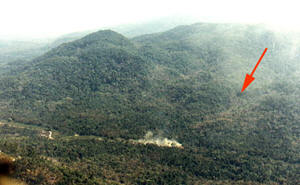 The
platoon we had been called to help had stumbled across NVA soldiers of the
NVA 33rd Regiment of the 3rd Division guarding
an NVA headquarters and
were pinned down and fighting for their lives. Every time a Soldier on the ground keyed the
microphone on his radio all you could hear was gunfire and yelling in the
background.
The
platoon we had been called to help had stumbled across NVA soldiers of the
NVA 33rd Regiment of the 3rd Division guarding
an NVA headquarters and
were pinned down and fighting for their lives. Every time a Soldier on the ground keyed the
microphone on his radio all you could hear was gunfire and yelling in the
background.
The 33rd Regiment was formed in 1965, and was deployed to South Vietnam
in 1966. The regiment quickly gained a reputation for its ferocity and its
ability to operate in difficult terrain. The 33rd Regiment was involved in a
number of major battles during the war, The Regiment was disbanded after the
war, but its legacy continues to this day. It is remembered as one of the
most effective and dangerous NVA units of the war.
Circling in a Light Observation helicopter (LOH) about a thousand feet above the ground unit was
LTC Bacon. Thought new to Vietname, he wanted to coordinate the mission and available assets ranging from
nearby ground forces, artillery, attack helicopters, resupply helicopters,
and medical evacuation helicopters. The LtC Bacon radioed us it was too dangerous to attempt a hoist mission and we were
ordered to keep circling the area south of where the firefight was being
conducted. Meanwhile the two Blue Max attack helicopters were trying to
suppress enemy fire by making low passes and firing their mini-guns. After
quite a lengthy delay our aircraft began running low on fuel, so I radioed
LTC Bacon we were departing the scene
and returning to LZ Mace to hot refuel. Hot refueling allowed us to land and
take on fuel without shutting off the Huey’s turbine engine.
Back at LZ Mace I kept the helicopter’s engine running
and all systems working as I waited for Fergie to quickly refuel our Medevac
helicopter. While we were on the ground the crewmembers loaded additional
ammunition and soon, we were returning to the firefight while monitoring the
current situation over the radio.
When we arrived on station for the
second time the unit on the ground was still in contact with the enemy and
the number of causalities had increased. My whole crew was thinking the same
thing I was, that this is going to be one of those bad missions where we really
work for our combat pay. After dozens of missions, some good and some bad,
you just get a feeling about the situation and how dangerous the mission may
possibly be.
I attempted numerous times to get permission
to conduct the rescue of the critically wounded, but the LTC Bacon ordered us to continue circling south of the
contact area. Knowing that for every minute that passed, the survival rate of
our critically wounded patients decreased, we kept circling, hoping that at
any minute, we’d be allowed to attempt the extraction of the wounded. We
normally just arrive over the patient location, conduct a quick aerial
reconnaissance, formulate a plan for approach and departure, and go for it.
Damn. the torpedoes! Having to wait and wait was unnerving; not the way we
usually operated. Our gunner, Coop, remembers Doc Nose giving him a plastic
bag to pee in once or twice because we were circling for such a protracted
time.
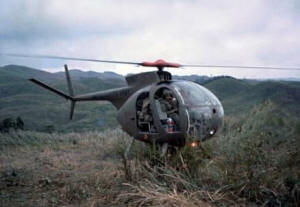 At some point the
LTC Bacon came up
with a plan to attempt to “burn out” the snipers by having the pilot hover
above each sniper and drop white phosphorus (Willy Pete) grenades on the sniper's
location. Willy Pete is extremely dangerous and deadly since it can burn
straight through metal in no time and through human skin and extremities in
seconds. Even when LTC Bacon was warned that he was hovering over the
friendlies, he dropped the WP grenade, it
bounced off the nearly impenetrable jungle canopy landing on the pinned down
US troops. This resulted in numerous Soldiers with white phosphorus burning
through their skin and as they stood up screaming, the snipers were killing
them one at a time.
At some point the
LTC Bacon came up
with a plan to attempt to “burn out” the snipers by having the pilot hover
above each sniper and drop white phosphorus (Willy Pete) grenades on the sniper's
location. Willy Pete is extremely dangerous and deadly since it can burn
straight through metal in no time and through human skin and extremities in
seconds. Even when LTC Bacon was warned that he was hovering over the
friendlies, he dropped the WP grenade, it
bounced off the nearly impenetrable jungle canopy landing on the pinned down
US troops. This resulted in numerous Soldiers with white phosphorus burning
through their skin and as they stood up screaming, the snipers were killing
them one at a time.
It was particularly dangerous for any Soldier who managed to
crawl over to the radio and help coordinate the mission. Periodically one of
the Soldiers would make it to the radio for a brief call for help. It seemed
anyone making it to the radio didn’t stay alive very long, which only added
to the confusion in conducting a safe hoist rescue of the wounded. But when
there was a radio call, all you could hear in the background were the
Soldiers sprayed with Willy Pete screaming as if they were on fire.
The memory of those screams still haunts me.
Though LTC Bacon ordered
us not to go in, our mantra was “to save a life.” I keyed the intercom and
asked the crew what they thought about disregarding the Colonel’s order and
try to conduct the mission and hopefully save some lives. It was unanimous;
everyone wanted to conduct the mission and try a rescue using the rescue
hoist.
Goldie contacted the ground troops and had them pop smoke and
I coordinated with the attack aircraft letting them know the avenue of
approach I would use. One Cobra attack aircraft started doing low orbits
above us providing mini-gun support and the other Cobra stayed in a higher
orbit allowing him to use his 2.5-inch folding fin rockets.
In
preparation for the hoist mission the whole crew went up “hot mike”,
allowing us all to communicate over the intercom without having to key our
microphone switches. I flew to where the largest concentration of smoke was
drifting up from the jungle canopy and began hovering above the jungle while
the crewmembers looked for the Soldiers on the ground. After a long couple
of minutes, we finally spotted the Soldiers, and I brought the helicopter to
a stationary hover high above the ground unit. Doc Nose threw down a
semi-ridged polless litter, which would allow the unit members to strap a
wounded S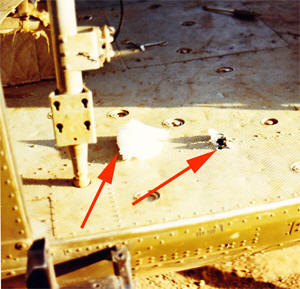 oldier in and we’d hoist the patient up to the aircraft in a
vertical orientation - head first. We couldn’t use, nor did we have
available, the rescue basket seen in many helicopter rescues that hoists a
litter patient in a horizontal orientation because the jungle canopy in the
1st Cavalry Division’s area of operation was often triple canopy and too
dense.
oldier in and we’d hoist the patient up to the aircraft in a
vertical orientation - head first. We couldn’t use, nor did we have
available, the rescue basket seen in many helicopter rescues that hoists a
litter patient in a horizontal orientation because the jungle canopy in the
1st Cavalry Division’s area of operation was often triple canopy and too
dense.
We
immediately started taking gunfire from the NVA soldiers, mostly from our
right side, with shrapnel from the bullets and aircraft skin hitting Coop in
the face and hands. Ferguson and Cooper were shooting their M-60's as fast
as they could, but it seemed to no avail. Being in this small box canyon,
with high ground on three sides, made us an easy target for the snipers and
other members of the enemy unit.
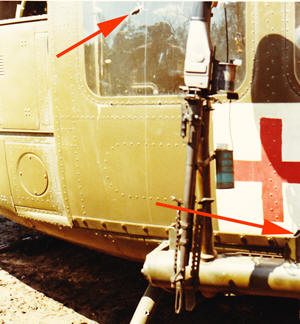 A
second attempt at hoisting the wounded Soldiers ended the same way as
before. We took such a volume of gunfire and bullet hits to the aircraft
that I was forced to fly our Medevac aircraft away from the contact area to
a nearby fire support base (FSB) to check our aircraft for damage.
A
second attempt at hoisting the wounded Soldiers ended the same way as
before. We took such a volume of gunfire and bullet hits to the aircraft
that I was forced to fly our Medevac aircraft away from the contact area to
a nearby fire support base (FSB) to check our aircraft for damage.
We were fortunate and although our aircraft had taken several hits,
Fergie didn’t think they were too serious. So, we loaded back up and
returned to attempt the extraction and rescue of the
wounded. We no sooner got over the friendly unit’s location than we started
taking heavy gunfire again.
This
time the NVA soldiers were sure we’d have to return to the same location and
had positioned themselves to do the most damage to us and our aircraft.
At one point, Coop had just leaned forward from his normal seated
position manning the right M-60 machine gun when a bullet whizzed behind his
head and struck Doc Nose in the shoulder area of his armor protective vest
(Chicken plate). After spinning him around the bullet continued and
instantly struck me in the back of my flight helmet. As Aircraft Commander
(AC) I was flying the helicopter so when the bullet entered my flight helmet
it flung me forward on the flight controls and the aircraft nosed down
diving toward the trees. At the same time, and this is all in nanoseconds,
Coop and Doc Nose were shouting into the intercom that they were hit. Goldie.
our poor newbie pilot, thought two crewmembers in the back were wounded and
his AC had been hit in the head so he immediately got on the flight controls
and kept the helicopter from nosing into the tree tops. He then flew us to
the same nearby FSB.
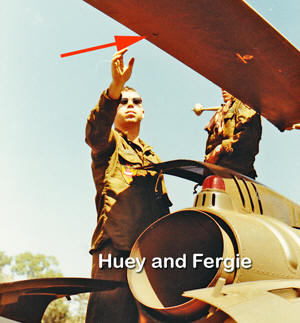 At about this time a sister Medevac helicopter, flown by
WO1 Gregg Simpson (Simp) was en route to LZ Mace on an "ash and trash"
mission delivering cargo to LZ Mace. He had been monitoring our mission and
hung around in case he was needed. I began briefing him, over
the radio, about the mission, our personal and aircraft situation and that
we were planning to trying the rescue again.
At about this time a sister Medevac helicopter, flown by
WO1 Gregg Simpson (Simp) was en route to LZ Mace on an "ash and trash"
mission delivering cargo to LZ Mace. He had been monitoring our mission and
hung around in case he was needed. I began briefing him, over
the radio, about the mission, our personal and aircraft situation and that
we were planning to trying the rescue again.
Upon
landing at the FSB, Fergie jumped from his seat on the left side to the
ground for a check of his aircraft. It seemed airworthy even to him even
though the aircraft had additional bullet holes. We loaded up again and as
Goldie brought the helicopter to a hover, Coop noticed Soldiers on the
ground frantically waving their arms and pointing to the engine area of our
aircraft. Coop got on the intercom and told me that he thought something
might be wrong. So, Goldie landed the bird back on the ground. Fergie jumped
out and found a severed fuel line and that the engine was spraying raw JP-4
jet fuel over the aircraft only inches away from the
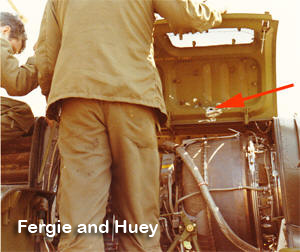 hot exhaust cowl.
Goldie immediately shut the engine off and we vacated the helicopter in what
can only be described as a "very brisk manner." That was all for this bird;
she was toast.
hot exhaust cowl.
Goldie immediately shut the engine off and we vacated the helicopter in what
can only be described as a "very brisk manner." That was all for this bird;
she was toast.
I
radioed Simp that our aircraft wasn’t airworthy and that he’d have to take
over the mission and attempt a hoist of the wounded. Simp's aircraft wasn't
equipped to conduct a medevac since it didn't have a medic, medical
equipment, or even a door gunner. But dedicated
as they were, Doc Nose and Coop insisted on trying to complete what they had
started so they loaded their gear on Simp's bird and were off to give it
another try. Doc Nose turned to Coop and said, “Third times a charm” and
Coop said, “Yes but for who - them or us?”
On arriving over the
hoist site Simp's aircraft immediately began receiving a barrage of gunfire.
Simp departed the site and insisted the ground unit move northwest away from
the NVA and toward the opening of the canyon. By carefully landing his
aircraft in a small open area, Simp was able to load four or five wounded
Soldiers.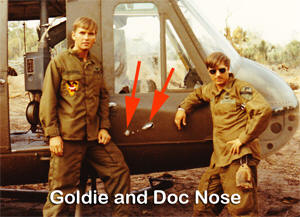
Fortunately, on his
way out to provide backup for us, Simp had radioed the next closest
helicopter ambulance unit to send a backup aircraft for his crew and
aircraft. Shortly, an aircraft flown by 1LT Tom Lacy, assigned to the 45th
Medical Company in Long Binh, arrived at the FSB for a briefing on the
mission and enemy situation.
This time was
better, the NVA soldiers had already departed and the crew was able to
complete the medevac mission. More than half the platoon had been killed by
the enemy and almost all of the remaining platoon members were casualties.
It was a long, harrowing day for everyone involved.
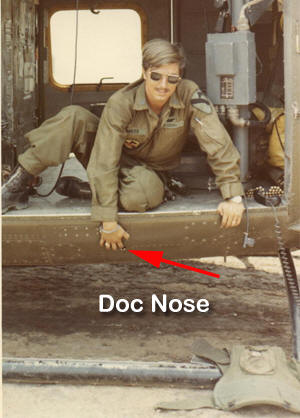 When we got back
to LZ Mace, I examined my helmet only to find a bullet that had pierced the
outer Fiberglas layer and stopped in the Styrofoam inner
layer without breaking the skin of my skull. Though I was jubilant about
surviving a bullet to the head with “my name on it”, I wasn’t overly happy
about the situation I was in since I had completely disregarded the lawful
orders of LTC Bacon who was the ranking officer at the scene. And sure enough,
in short order, I was summonsed to a command bunker to “chat” with LTC Bacon. You know how it goes,
“Yes sir, yes sir…never again sir.” After all, what was he going to do –
send me to Vietnam? To my surprise, and relief, LTC Bacon praised my crew
and thanked me for trying so earnestly to evacuate his unit members. He
ended his brief remarks by mentioning something about putting my crew in for
commendations.
When we got back
to LZ Mace, I examined my helmet only to find a bullet that had pierced the
outer Fiberglas layer and stopped in the Styrofoam inner
layer without breaking the skin of my skull. Though I was jubilant about
surviving a bullet to the head with “my name on it”, I wasn’t overly happy
about the situation I was in since I had completely disregarded the lawful
orders of LTC Bacon who was the ranking officer at the scene. And sure enough,
in short order, I was summonsed to a command bunker to “chat” with LTC Bacon. You know how it goes,
“Yes sir, yes sir…never again sir.” After all, what was he going to do –
send me to Vietnam? To my surprise, and relief, LTC Bacon praised my crew
and thanked me for trying so earnestly to evacuate his unit members. He
ended his brief remarks by mentioning something about putting my crew in for
commendations.
Sure enough a few days later, at sunrise, I had to have the whole crew
standing at attention as the Assistant Division Commander of the 1st Cavalry
Division arrived in a jeep
for a short ceremony to pin medals on our chest. It turns out the Colonel
really had submitted awards for the whole crew. Unfortunately, he didn’t
realize the brave extra efforts of Doc Nose and Coop and awarded them
commendations that were inferior for the bravery they exhibited. Ahh… but
that leads to yet another story for another time about how Doc Nose told the
general to shove it.
[ Return To Index ]